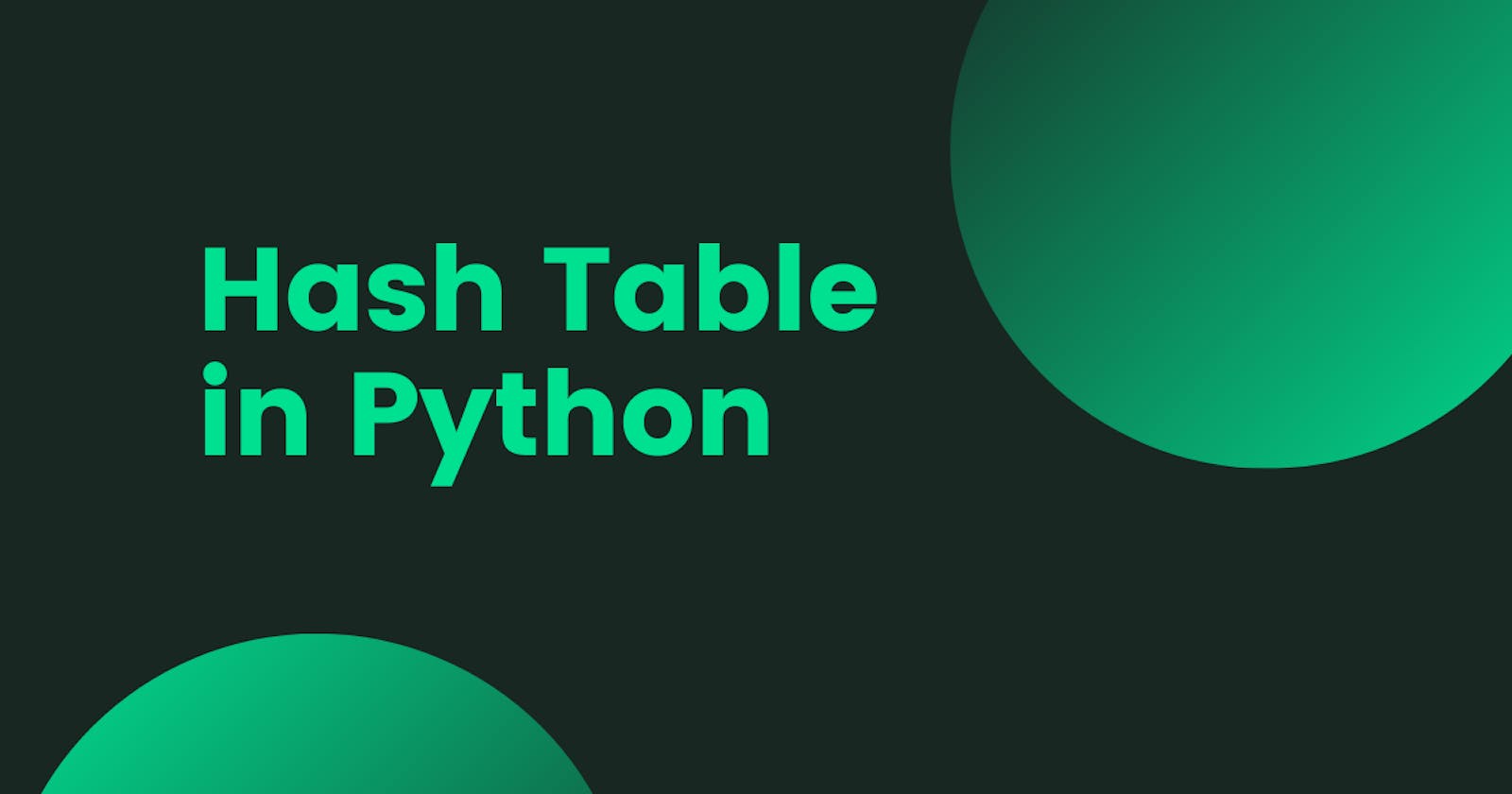What is Hash Table?
A hash table is a data structure that implements an associative array abstract data type, a structure that can map keys to values. In other words, we can say that the Hash Table is a data structure that stores the values using a KEY: VALUE pairs.
In Python, we make use of Dictionaries to store data values in KEY: VALUE pairs. . So Dictionaries is the Python-specific implementation for the Hash Table or Hash Map . Though we can implement the same thing using 2D Arrays.
In the example given below, we are storing the price of the fruits and then printing the desired fruit price.
mydict = {'Apple' : 25 , 'Oranges' : 40 , 'Banana' :12 }
print(mydict['Apple'])
Memory Representation in Hash Table
When you create a Dictionary the first thing it does is creates an array of a random size (here it creates Array of size 10) to store the Value
Then it takes the first Key, this Key will be matched to specific Value in the list, and to get the index of the Value we make use of Hash Function
See the below example, how march 6 is mapped with 310 in the List using the hash function.
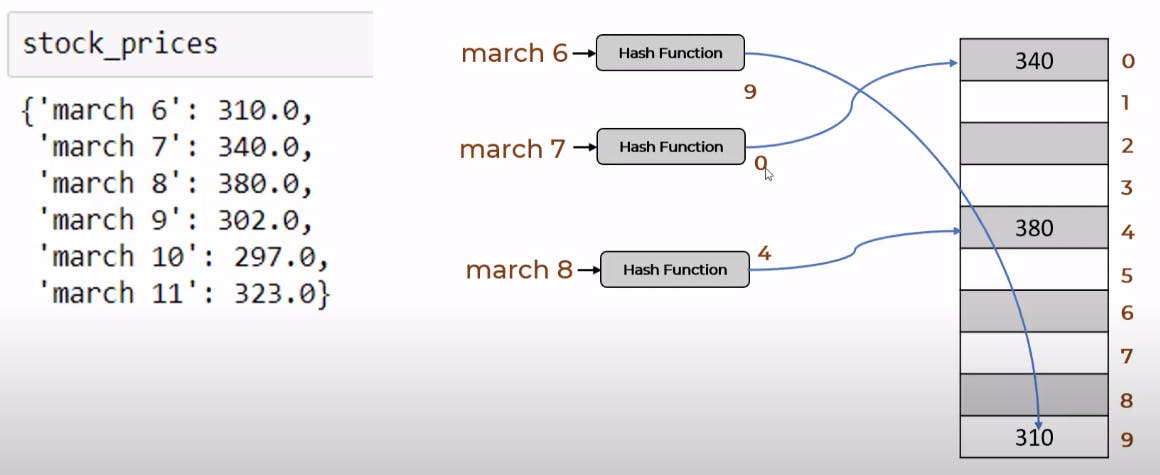
What is Hash Function?
A hash function is a function that takes a set of inputs of any arbitrary size and fits them into a table or other data structure that contains fixed-size elements.
There are various ways to implement this hash function . Today we will see one way which is using ASCII Numbers.
Let's take the above example and see how march 6 was mapped with 310
- The ASCII representation of ASCII of march 6 including space will be :

Since initially we assigned the Array = 10 . we can perform a MOD operation : MOD ( 609/10 ) --> 9
So this is you generated 9 using Hash Function.

- And then the value 310 is placed at the Index 9
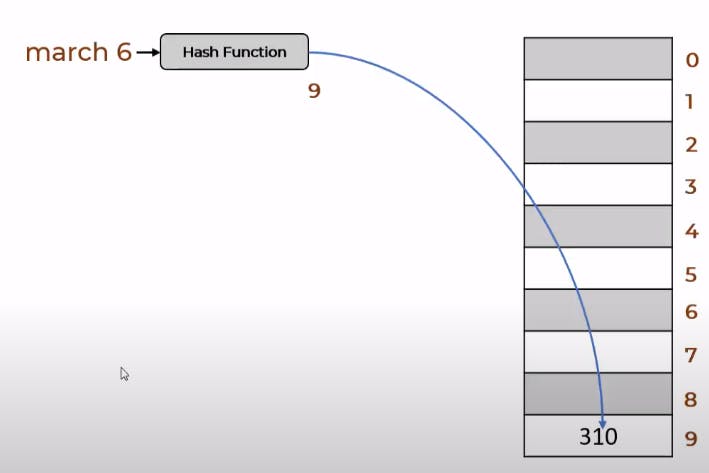
Let's Implement Hash Table in Python
- First, we create a Hash Function which will give the sum of ASCII Values
def hash_key(key): # funtion for finding the hash key using ASCII
h = 0 # this is varialbe for saving the sum
for char in key:
h += ord(char) #ord - will convert each character in the key to the ASCII value
return h % 100 # assuming that 100 will the size of the list so we are calculating mod using 100
- Defining a Hash Table class and implementing the above function
class HashTable:
def __init__(self):
self.max = 100 #for initiating 100 sized list
self.arr =[None for i in range(self.max)]
def hash_key(self,key): # funtion for finding the hash key using ASCII
h = 0 # this is varialbe for saving the sum
for char in key:
h += ord(char) #ord - will convert each character in the key to the ASCII value
#print(h%self.max)
return h % self.max # assuming that 100 will the size of the list so we are calculating mod using 100
if __name__ == '__main__':
t = HashTable()
t.hash_key('march 6')
- Creating a function adding a Key: Value pairs
def add(self,key,value):
h = sef.hash_key(key)
self.arr[h]= value
- Creating a function for returning the Value using the input Key
def get(self,key):
h = self.hash_key(key)
#print(self.arr[h])
return self.arr[h]
- Let's Integrate all the functions under the class Hash Table
class HashTable:
def __init__(self):
self.max = 100 #for initiating 100 sized list
self.arr =[None for i in range(self.max)]
def hash_key(self,key): # funtion for finding the hash key using ASCII
h = 0 # this is varialbe for saving the sum
for char in key:
h += ord(char) #ord - will convert each character in the key to the ASCII value
#print(h%self.max)
return h % self.max # assuming that 100 will the size of the list so we are calculating mod using 100
def add(self,key,value):
h = self.hash_key(key)
self.arr[h]= value
def get(self,key):
h = self.hash_key(key)
#print(self.arr[h])
return self.arr[h]
if __name__ == '__main__':
t = HashTable()
t.hash_key('march 6')
t.add('march 6',310)
t.get('march 6')
Though you will not use this Hash Table in Python because there is already Dictionary . Dictionaries are Python's implementation of a Hash Table or Hash Map that is more generally known as an associative array. A dictionary consists of a collection of key-value pairs. Each key-value pair maps the key to its associated value.
Collision Handling
What Happens in Collision
In the above examples, we saw how the Key was matched with the Index of the value using Hash Functions .
Assume a situation where more than one Keys are assigned the same Index by the hash function. This is known as Collision.
In the below example both march 6 and march 17 are assigned the Index 9

How to handle collisions
Chaining
In order to handle collisions we can make use of a method called Chaining
In Chaining Instead of directly storing the Value at the Index, we can store a Linked List of the Key-Value Pairs
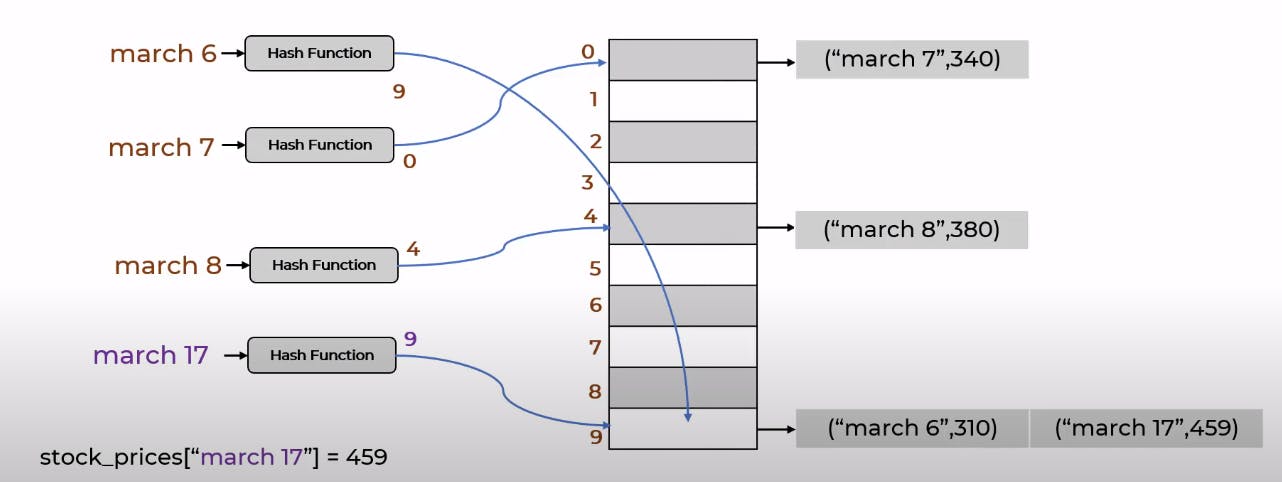
Implementing Chaining in Python
- Initializing an Empty Array, because each value is storing KEY-VALUE pair
def __init__(self):
self.max = 100 #for initiating 100 sized list
self.arr =[[] for i in range(self.max)]
- All Other function remains the same. Now we need to edit the ADD function because while fetching the Value we need to iterate through the Array
def add(self,key,value):
h = self.hash_key(key)
found = False
for idx,element in enumerate(self.arr[h]):
if element[0]== key and len(element) == 2:
self.arr[h][idx] = (key,value)
found = True
break
if not found:
self.arr[h].append((key,value))
- Now In-order to get the required value from the key we need to update the GET function as well
def get(self,key):
h = self.hash_key(key)
for each in self.arr[h]:
if each[0] == key:
#print(each[1])
return each[1]
- Let's Integrate all the functions under the class Hash Table
class HashTable:
def __init__(self):
self.max = 100 #for initiating 100 sized list
self.arr =[ [] for i in range(self.max)]
def hash_key(self,key): # funtion for finding the hash key using ASCII
h = 0 # this is varialbe for saving the sum
for char in key:
h += ord(char) #ord - will convert each character in the key to the ASCII value
#print(h%self.max)
return h % self.max # assuming that 100 will the size of the list so we are calculating mod using 100
def add(self,key,value):
h = self.hash_key(key)
found = False
for idx,element in enumerate(self.arr[h]):
if element[0]== key and len(element) == 2:
self.arr[h][idx] = (key,value)
found = True
break
if not found:
self.arr[h].append((key,value))
def get(self,key):
h = self.hash_key(key)
for each in self.arr[h]:
if each[0] == key:
#print(each[1])
return each[1]
if __name__ == '__main__':
t = HashTable()
t.add('march 6',310)
t.add('march 17',400)
t.add('march 6',489)
t.get('march 6')
Linear Probing
Second Method is Linear Probing. In this case when we see that an Index is already filled then it searches for a new Index and keeps on finding Index until it's empty.
In the below example you can see how march 17 is stored at the Index 1
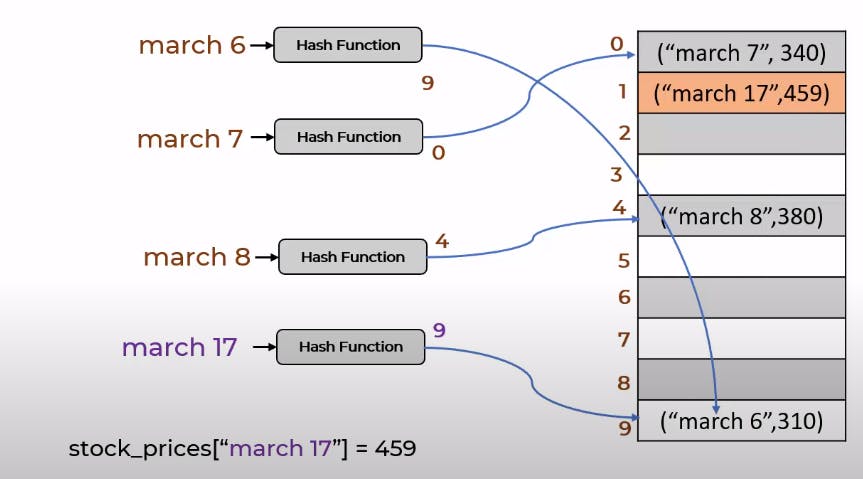
Now you can try Implementing Linear Probing in Python.
Thank-you!
I am glad you made it to the end of this article. I hope you got to learn something, if so please leave a Like which will encourage me for my upcoming write-ups.
- My GitHub Repos
- Connect with me on Linkedin
- Start your own blogs

